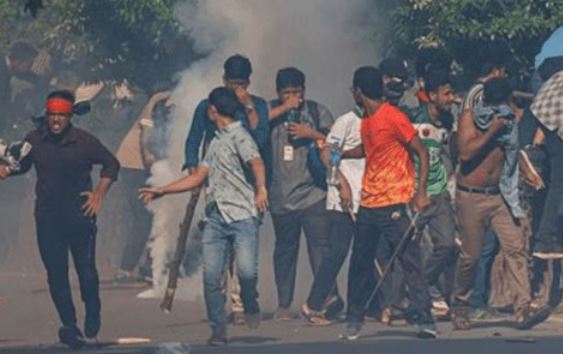Nationwide Curfew and Military Deployment
In response to the escalating violence, the Bangladesh government has imposed a curfew across the country and deployed the military to restore order. Prime Minister Sheikh Hasina’s press secretary, Nayeemul Islam Khan, confirmed this decisive action, which aims to quell the widespread student-led protests against government job quotas. The official announcement of the curfew is imminent, as authorities scramble to regain control amidst growing unrest.
Protests Turn Violent
The protests, initially sparked by opposition to quotas reserving 30% of government jobs for families of those who fought for independence from Pakistan, have spiraled into widespread chaos. On Friday, three individuals were killed in clashes with police, despite a ban on public gatherings. Police resorted to firing tear gas to disperse protesters, who retaliated by setting fires across Dhaka, causing plumes of smoke to rise over the city.
The unrest has been marked by severe disruptions to telecommunications, with authorities cutting some mobile services to hinder the coordination of protests. Television news channels were taken off the air, and internet services were crippled, further exacerbating the sense of crisis.
Death Toll and Injuries
The violence has claimed a significant number of lives, with Bengali newspaper Prothom Alo reporting 27 deaths and 1,500 injuries on Thursday alone. By Friday night, the death toll had reached 105, according to AFP, though Reuters could not independently verify these figures. The U.S. Embassy in Dhaka reported over 40 deaths and hundreds, potentially thousands, injured, highlighting the severity of the situation.
The Roots of Unrest
The protests reflect deep-seated frustrations among the youth, who face high unemployment rates in a country where nearly a fifth of the population is under 30. The economic strain of high inflation and dwindling foreign exchange reserves has compounded these grievances, driving the unrest beyond the initial issue of job quotas.
The protests have also revived historical and political tensions between those who fought for Bangladesh’s independence and those accused of collaborating with Pakistan. Prime Minister Hasina’s Awami League party, rooted in the independence movement, has faced fierce opposition from students and other groups, who have labeled the protesters as “razakars,” a term for collaborators.
International Reactions and Communication Blackout
International rights groups have condemned the government’s heavy-handed response and the suspension of services. The European Union expressed deep concern over the violence and loss of life, urging a peaceful resolution based on the rule of law and democratic freedoms. Neighboring India, while deeming the unrest an internal matter for Bangladesh, confirmed the safety of its citizens residing in the country.
The protests have had far-reaching effects, even triggering clashes in London, home to a significant Bangladeshi diaspora. Meanwhile, back in Bangladesh, a group identifying as “THE R3SISTANC3” hacked official websites, including those of the central bank and the prime minister’s office, posting messages condemning the government’s actions and calling for an end to the violence.
Government Response and Future Prospects
Despite the turmoil, the government has expressed willingness to engage in dialogue with the protesters. However, this offer has been rejected by the demonstrators, who remain steadfast in their demands. Many opposition leaders and student activists have been arrested, further fueling the unrest.
As the government grapples with the crisis, the long-term implications of this upheaval remain uncertain. The current situation underscores the urgent need for comprehensive solutions to address the underlying economic and social issues driving the protests.
Summary
Bangladesh is engulfed in a severe crisis, with violent protests against government job quotas leading to a nationwide curfew and military deployment. The unrest, fueled by economic woes and historical tensions, has resulted in significant casualties and widespread disruptions to communications. The government’s response and the eventual resolution of this crisis will shape the country’s political and social landscape for years to come.
Key Learning Points:
| Key Points | Details |
|---|---|
| Nationwide Curfew | Government imposes curfew and deploys military to control protests. |
| Violent Protests | Protests against job quotas turn violent, with significant casualties. |
| Communication Disruptions | Telecommunications and internet services disrupted nationwide. |
| Economic and Historical Tensions | Protests driven by high unemployment, inflation, and historical grievances. |
| International Reaction | International condemnation and concern over the government’s response. |
| Government’s Offer of Dialogue | Government expresses willingness to engage in dialogue, but protesters remain resolute. |
Soumya Smruti Sahoo is a seasoned journalist with extensive experience in both international and Indian news writing. With a sharp analytical mind and a dedication to uncovering the truth, Soumya has built a reputation for delivering in-depth, well-researched articles that provide readers with a clear understanding of complex global and domestic issues. Her work reflects a deep commitment to journalistic integrity, making her a trusted source for accurate and insightful news coverage.



